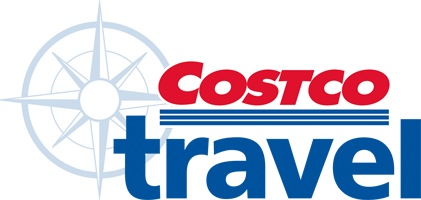
Europe and Mediterranean: European Jewels Cruise
Uniworld Boutique River Cruises
Discover the grand sweep of history and the dynamic present along legendary rivers on a magnificent journey that gives you the best of Europe's great treasures as well as off-the-beaten-path gems.

True All-Inclusive Boutique River Cruising™
All gratuities for onboard services
Unlimited fine wine, beer, spirits and nonalcoholic beverages**
Shore excursions with local experts as your guide
Internet and Wi-Fi
All arrival and departure day transfers
Locally sourced cuisine
Executive Member Benefit
Executive Members receive an annual 2% Reward, up to $1,000, on qualified Costco Travel purchases
Receive a $50 shipboard credit per person (maximum $100 per stateroom)♦
Digital Costco Shop Card
Member Exclusive: Digital Costco Shop Card with every Uniworld® river cruise†
Sailing Itinerary

Note: Cruise itineraries are subject to change. Please verify ports and times directly with the cruise line.
Overview
Amsterdam is the Netherlands’ capital, known for its artistic heritage, elaborate canal system and narrow houses with gabled facades, legacies of the city’s 17th-century Golden Age. Its Museum District houses the Van Gogh Museum, works by Rembrandt and Vermeer at the Rijksmuseum, and modern art at the Stedelijk. Cycling is key to the city’s character, and there are numerous bike paths.
Overview
Amsterdam is the Netherlands’ capital, known for its artistic heritage, elaborate canal system and narrow houses with gabled facades, legacies of the city’s 17th-century Golden Age. Its Museum District houses the Van Gogh Museum, works by Rembrandt and Vermeer at the Rijksmuseum, and modern art at the Stedelijk. Cycling is key to the city’s character, and there are numerous bike paths.
Overview
Cologne (Köln), the largest city in the Rhineland, is so rich in antiquity that every time a new foundation is dug, the excavators come up with archaeological finds. Devastating though the World War II bombing was - nearly all the buildings of the Altstadt were damaged - reconstruction brought to light a period of Cologne's history that had been a mystery for centuries. Evidence showed that Cologne was as important and powerful during the early Christian era as it was during Roman times and the Middle Ages. Cologne traces its beginnings to 38 B.C., when Roman legions set up camp here. As early as A.D. 50, the emperor Claudius gave it municipal rights as capital of a Roman province. In the early Christian era, a bishopric was founded here and a number of saints were martyred, including the patron of the city, St. Ursula. During the Middle Ages, as Cologne became a center for international trade, Romanesque and Gothic churches were built with prosperous merchants' gold. Today there is much to see from every period of the city's 2,000-year history - from the old Roman towers to the modern opera house. But Cologne is also a bustling modern city, with a lively population. It's also increasingly becoming the fine-art capital of Germany.
Overview
Rüdesheim is among the Rhine's most delightful towns. The lively Drosselgasse, a narrow cobbled lane, is renowned for its cozy restaurants and wine taverns filled with music and merriment. The grand 16th century Bromserhof houses a fascinating collection of mechanical musical instruments, while the 10th century Bromserberg Castle serves as a museum of the Rheingau wine region's bounty.
Overview
Frankfurt am Main is the largest city in the German state of Hesse and the fifth largest city of Germany. Situated on the Main River, it has a population of approximately 650,000 (but about 5 million in its metropolitan area). Among English speakers it is usually known as simply Frankfurt, but Germans call it by its full name so as to distinguish it from another Frankfurt in Germany, Frankfurt an der Oder. It was once called Frankfort-on-Main in English, a direct translation of Frankfurt am Main. The three pillars of Frankfurt's economy are finance, trade fairs, and transport; it is the transport hub of Germany. Frankfurt has been Germany's financial capital for centuries. Frankfurt is often called "Bankfurt" or "Mainhattan" (derived from the local Main River). It is one of only three European cities that have a significant number of high-rise skyscrapers. With 9 skyscrapers taller than 150 meters (492 feet) in 2004, Frankfurt is second behind Paris (La Défense and Montparnasse: 12 skyscrapers taller than 150 meters, not counting the Eiffel Tower), but ahead of London (Canary Wharf and City: 8 skyscrapers taller than 150 meters). The city of Frankfurt contains the tallest skyscraper in Europe, the Commerzbank Tower. In Germany, only Frankfurt and Düsseldorf have high-rise skyscrapers. Frankfurt is renowned for its finance industry, on a par with London and Paris, as well as for its central location in Western Europe, surrounded by the most populous areas of Europe. It has a first-class infrastructure and a major international airport: Frankfurt International Airport. It is the second or third busiest in Europe, depending on the data used. Passenger traffic at in 2003 was 48,351,664, second in Europe behind London Heathrow Airport (63,487,136), almost in a tie with Paris Charles de Gaulle Airport (48,220,436). Frankfurt has a huge number of institutions, among them its university, Johann Wolfgang Goethe-Universität, as well as a number of museums, most of them lined up along the Main river on the Museumsufer (museum shore) and a large botanical garden, the Palmengarten. The best-known museums are the Städelsches Kunstinstitut und Städtische Galerie, called Städel, and the Naturmuseum Senckenberg. The Museum für moderne Kunst (Museum of Modern Art) and Schirn Kunsthalle (Schirn Art Galery) are also notable.
Overview
Wertheim Village, Germany's first premium outlet shopping destination, is nestled within the picturesque wine-growing region of the Tauber Valley, and near to Wertheim, one of the country's most beautiful and romantic towns. The City of Wertheim, with its romantic historic town centre, a prominent Relais & Chateaux Resort, numerous traditional restaurants, and a wide range of recreational and cultural amenities, is a well-established tourist destination popular with the residents of Frankfurt and its many affluent suburbs. Crowned by the spectacular ruins of Wertheim Castle, the city and its surroundings have long served as a preferred destination for scenic, cultural and gastronomic enjoyment. A dedicated shuttle service connects the historic city centre to Wertheim Village. Wertheim Village is strategically located at Junction 66 - Wertheim/Lengfurt - of the A3 Autobahn, within 60 minutes from each of Frankfurt and Nuremberg. The Village is in the State of Baden-Württemberg and on the border of Bavaria. It enjoys over 500 metres of motorway frontage and sits prominently on an idyllic hillside offering a spectacular view to the more than 23.5 million vehicles passing the site each year. Moreover, Wertheim's location just west of the Autobahn A3/A7 interchange makes it readily accessible to the more than 50 million people annually passing through the region. The design of Wertheim Village is a creative interpretation of the regional Franconian architectural style, using exquisite details and high-quality materials to express the historic traditions of building craft for which the region is world famous. Varied façades, an animated roofscape, decorative art detailing and rich landscaping provide customers with a unique, engaging and romantic shopping environment. The Village has spacious and high-quality restrooms, baby changing facilities, a Tourist Information Centre aimed at promoting the Village and the region as a major tourist destination, public phones, restaurants and cafés, and amenities to provide a satisfying customer visit. Wertheim Village is located near the intersection of the famed Castle Route and the Romantic Road - two of the most important and popular tourist itineraries in Europe. Reaching from Mannheim to Prague, and from nearby Würzburg to the Alps, this dynamic tourist region includes such nearby destinations as Rothenburg ob der Tauber, with some 2.5 million annual visitors, the UNESCO World Heritage Residenz Castle in Würzburg, mediaeval Nuremberg with its world-famous Christmas Market, plus countless castles, forts, wineries and spas. Other important sources of tourism are the frequent trade fairs and congresses in Frankfurt, which attract an additional 12 million international visitors to the region each year.
Overview
Wurzburg is a city in Germany's Bavaria region. It's known for lavish baroque and rococo architecture, particularly the 18th-century Residenz palace, with ornate rooms, a huge fresco by Venetian artist Tiepolo and an elaborate staircase. Home to numerous wine bars, cellars and wineries, Wurzburg is the center of the Franconian wine country, with its distinctive bocksbeutel (bottles with flattened round shapes).
Overview
Kitzingen is part of the governmental district of lower Franconia in the Free State of Bavaria. Those who visit Kitzingen will find it's history closely linked with the growth of grapes and the cultivation of wine. Throughout history the selling of wine was the main source of income for the citizens of Kitzingen. This part of history is very much in evidence today as the rolling hills around the town are covered with grapevines. There are many examples of interesting architecture in the area. The "FALTERTURM" (Market tower) is one of the most recognizable sites in Kitzingen. The ivy covered tower was built between 1469 and 1496 as a watch tower of the outer city walls. The pointed roof of the tower leans noticeably to one side. Legend has it that during it's construction, there was a shortage of water and a surplus of wine. The masons used the wine instead of water to set the mortar and the wooden beams were not properly fixed. This serves not only as an example of the architecture of the area, but as one of the many colorful legends of Germany. There are many cultural attractions in Kitzingen. There are two well known sculptures at the City Hall, the "Hacker" - a laborer working in the vineyards - and his partner the "Cathedral", holding goblets in their hands. The selling of wine is a main source of income for many citizens, and this trade can be followed through history. The "Falterturm " which is a leaning tower, is the characteristic feature of the town.
Overview
Situated in the heart of Upper Franconia, Bamberg is an historical yet dynamic city. It is a town of tradition and progress, both of which successfully complement each other. In short, Bamberg is a beautiful city which for many reasons is always worth a visit. The locals like to stress that their city spreads across seven hills like Rome, has a network of waterways like Venice, and an old city which is at least as beautiful as Prague and on which the same architects left their unmistakable mark. Those who know Bamberg will agree that these claims are not unjust. A glance at just four of the many sights is enough to understand why. The Old Town Hall, which like the bow of a ship parts the flow of the River Regnitz, can only be reached by two stone bridges; the Romanesque/Gothic Cathedral is endowed with four unique towers of the same height; the picturesque fishermen's houses of "Little Venice" prop each other up on the river bank and the magnificent New Residence boasts a splendid baroque room known as the Emperor's Hall. Bamberg is not just a work of art which happens to be of historical interest but a dynamic, pulsating city with a population of 70,000. Bamberg has all the facilities a city, its inhabitants and visitors need. It is ideal for shopping, working and living, for spending holidays and holding conferences. After just a few hours in Bamberg, every visitor comes away with that special Bamberg feeling. Bamberg offers a wide and interesting range of leisure facilities; it knows how to please the eye, appeal to the ear and surprise the tastebuds. In summer, Bamberg's beer cellars or "Keller" are a special attraction. Here the locals and tourists can appreciate a locally brewed beer and savour a typical Franconian snack. Bamberg is a lovely town for those who also enjoy a stroll. The possibilities are many and include the Hain, an extensive wooded park on the periphery, or the pretty paths along the canals and the River Regnitz. Bamberg has a lot to offer not only for those who have cultural leanings, but also for those who enjoy sports.
Overview
Nuremberg is the largest city in Franconia and the natural centre of North Bavaria. In terms of population it is the second largest city in Bavaria and the thirteenth largest in Germany. Together with its neighbours Fürth, Erlangen, Schwabach and the surrounding rural districts, Nuremberg is part of one of Europe’s most important economic areas, where the EU and its Eastern neighbours meet. Nuremberg is surrounded by attractive landscapes: to the East the Franconian hills, to the North "Franconian Switzerland" and to the South-West the Franconian Lakes. Centuries of art and architecture made Nuremberg a treasure. During the 15th and 16th centuries, Nuremberg enjoyed a cultural flowering that made it the center of the German Renaissance, bringing together Italian Renaissance and German Gothic traditions. In the artists' workshops were found such great talents as Veit Stoss, Peter Vischer, Adam Krafft, Michael Wolgemut, and above all, Albrecht Dürer. Koberger set up his printing press here, and Regiomontanus built an astronomical observatory. Here, too, flourished the guilds of the Meistersingers, composed of prosperous artisans; Wagner made their most famous member, Hans Sachs, the hero of his opera Die Meistersinger von Nuremberg. Many of Nuremberg's most important buildings, including some of the finest churches in Germany, have been restored or reconstructed. The old part of the city, the Altstadt, lies mainly within a pedestrian zone. Today's visitors can see the ruins of the ramparts that once surrounded the city as well as more modern sites, such as the Justice Palace, where the War Crimes Tribunal sat in 1946. Visitors can also see the Zeppelinfeld arena, the huge amphitheater where, from 1927 to 1935, Hitler staged those dramatic Nazi rallies that were immortalized by Leni Riefenstahl in Triumph des Willens (Triumph of the Will). Hitler's architect, Albert Speer, constructed what has been called a "concrete mecca," whose grounds today have been turned into a park with apartment blocks, a trade fair, and a concert hall. Speer's Congress Hall, larger than the Colosseum in Rome, has become a recording studio and warehouse.
Overview
Regensburg is widely regarded as the medieval wonder of Germany – a historic city in a unique state of preservation, living witness to two thousand years of rich and colourful history. At every turn one encounters truly outstanding historical monuments and architectural marvels. The experience is deepened by the exquisite collections at the city’s fine museums, and made yet more enjoyable by the typically warm Bavarian hospitality of the locals. Located on the beautiful Danube, Regensburg is also the perfect starting-place for river cruises and excursions.
Overview
The town on the three rivers – the Danube, the Inn and the Ilz – got its name from the Roman fort of Batavis. After 739 AD Passau grew to become the biggest bishopric on the Danube, its domain extending all the way to Hungary. After the great fire of 1662 the prince bishops rebuilt the town in the Baroque style. One of the highlights of the Old Town is the beautiful Cathedral of St Stephan, which boasts the biggest church organ in the world. High up above the town and the rivers stand the Veste Oberhaus Castle and the Maria Hilf Abbey, both of which are also well worth a visit.
Overview
"Weissenkirchen" means "white church" and this name refers to the village's impressive multi-purpose church, which served both as a centre of worship and a fortification to protect the villagers from plundering Turks. It was originally built in the 14th century, but the defence tower was added in 1531. Similar to many other churches in Austria, the interiors are a rather unimpressive mix of Gothic and Baroque art.
Overview
Today, Vienna is once again in the center of Europe. But not so long ago, Vienna was just on the western side of the Iron Curtain. Many visitors are surprised to learn that Vienna is actually further east than Prague and Berlin. Vienna was once the heart of a vast realm, the Habsburg Empire. For a time, the possessions of the Habsburgs, who ruled for more than 600 years, were so far-flung that it was said that the sun never set on its dominions. All that came to an end more than 80 years ago. Today, Austria is a small country of about eight million people. But Vienna still has heart. It is one of the most comfortable, interesting, beautiful capital cities in the world. The Vienna of today is a modern, international metropolis in the heart of Central Europe, a city with a quality lifestyle and an embraceable joy for living. Vienna caters to your needs in terms of education, social and health services and also offers a wide range of leisure and cultural activities.
Overview
Budapest, Hungary’s capital, is bisected by the River Danube. Its 19th-century Chain Bridge connects the hilly Buda district with flat Pest. A funicular runs up Castle Hill to Buda’s Old Town, where the Budapest History Museum traces city life from Roman times onward. Trinity Square is home to 13th-century Matthias Church and the turrets of the Fishermen’s Bastion, which offer sweeping views.
Overview
Budapest, Hungary’s capital, is bisected by the River Danube. Its 19th-century Chain Bridge connects the hilly Buda district with flat Pest. A funicular runs up Castle Hill to Buda’s Old Town, where the Budapest History Museum traces city life from Roman times onward. Trinity Square is home to 13th-century Matthias Church and the turrets of the Fishermen’s Bastion, which offer sweeping views.
Onboard the S.S. Beatrice
S.S. Beatrice
Year Built: 2018
Double Occupancy Capacity: 152
The S.S. Beatrice boasts yacht-style light wood with blue and white finishes throughout, a renovated lobby featuring elegant mirrors, marble floors, a white Murano chandelier with blue shades and a grand staircase made of nickel and black iron—a signature design element of Uniworld’s Super Ships. The ship’s redesigned lounge features sofas and chairs with hand-made upholstery, a parquet floor and upholstered ceiling panels, solar shades and new USB ports allowing guests to charge anywhere they are sitting. The artwork throughout the ship includes pieces from Pablo Picasso, Alexander Calder and Pino Signoretto.
Activities & Services (included in cruise)
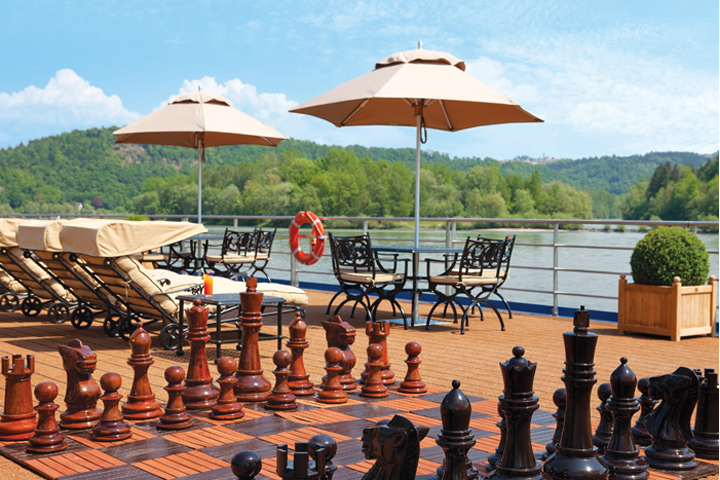
Sundeck
- Movies
- Beauty Salon
- Fitness Center
- Sauna/Steam Room
- Bars/Lounges
- Library
- Concierge Desk
- Duty-Free Shops/Boutiques
- Elevators
- Safe Deposit Boxes
Activities & Services (available for an extra fee)
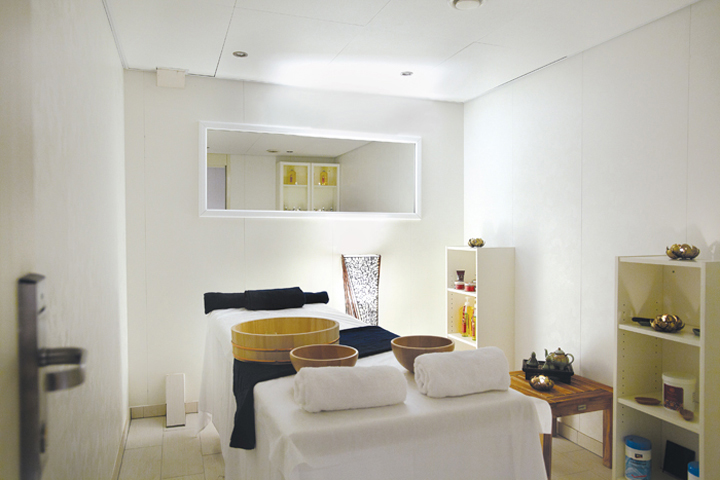
Spa
- Internet Center
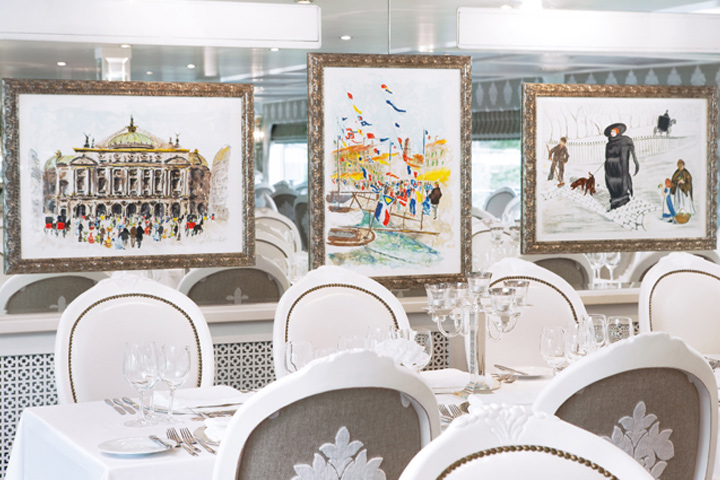
Main Dining Room
Main Dining
Main Dining Room (open seating): This seating option allows you to choose when and with whom you dine. Menus are a blend of classic cuisine with a touch of contemporary elegance, and are created using only the finest and freshest ingredients often brought onboard from local ports of call. You'll be surrounded by the beauty of passing riverbank towns and villages.
Luxurious riverview stateroom featuring handcrafted Savoir® Beds of England, built-in closets, hair dryer, safe, individual climate-controlled thermostat, direct-dial telephone, mineral water and flat-screen TV. Enjoy a marble bathroom with Asprey bath and body products, plush towels, backlit magnifying mirror, cozy bathrobes and slippers.
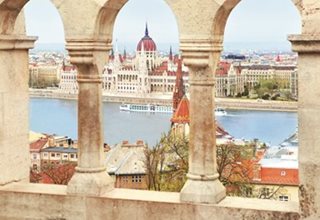
Category: CL
Luxurious riverview stateroom with a French balcony featuring handcrafted Savoir® Beds of England, built-in closets, hair dryer, safe, individual climate-controlled thermostat, direct-dial telephone, mineral water and flat-screen TV. Enjoy a marble bathroom with Asprey bath and body products, plush towels, backlit magnifying mirror, cozy bathrobes and slippers.
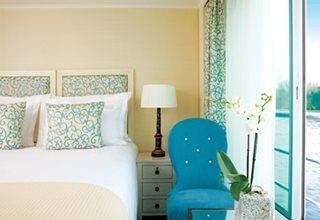
Category: FB

Category: DF
Luxurious riverview suite featuring handcrafted Savoir® Beds of England, built-in closets, hair dryer, safe, individual climate-controlled thermostat, direct-dial telephone, mineral water and flat-screen TV. Enjoy a marble bathroom with Asprey bath and body products, plush towels, backlit magnifying mirror, cozy bathrobes and slippers.
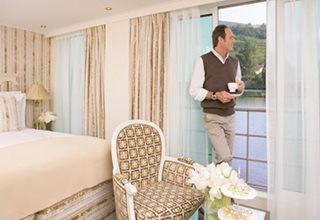
Category: S
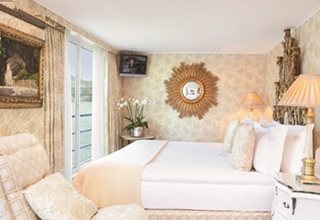
Category: GS
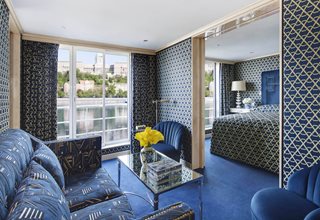
Category: ROY

| Symbol | Description |
|---|
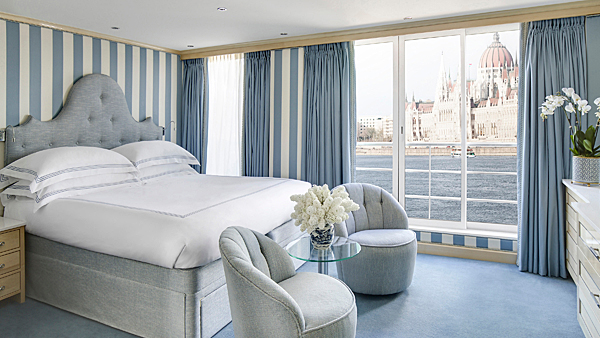
- Ship Name: S.S. Beatrice
- Year Built: 2018
- Year Entered Present Fleet: 2018
- Ship Class: River
- Maximum Capacity: 152
- Number of Passenger Decks: 3
- Number of Crew: 55
- Officers' Nationality: International
- Ocean-View without Balcony: 10
- Ocean-View with Balcony: 50
- Capacity Based on Double Occupancy: 152
- Country of Registry: The Netherlands
- Total Staterooms: 76
- Suites with Balcony: 16
- Crew/Hotel Staff Nationality: International
Available Dates & Prices
Terms & Conditions
*Price shown is per person based on double occupancy and is valid for select stateroom categories only. Click on the Terms & Conditions link below for details.
**Unlimited beverages include premium wine and premium spirits. Diamond List of wine and spirits is available at an additional cost.
♦Executive Members receive a $50 shipboard credit per person, maximum $100 per stateroom. Executive Member benefit is valid for primary cardholder only. Shipboard credit is per stateroom based on double occupancy. Shipboard credit will be applied to your onboard account. Any unused portion of the credit is nontransferable, nonrefundable and not redeemable for cash.
†One Digital Costco Shop Card per room/stateroom, per stay. The exact amount of the Digital Costco Shop Card will be calculated during the booking process. The Digital Costco Shop Card promotion is nontransferable and may not be combined with any other promotion. A Digital Costco Shop Card will arrive by email approximately 10 days after the start of your cruise. Click on the Terms & Conditions link below for additional information.
Ship's registry: The Netherlands
Digital Costco Shop Card
This booking includes a Digital Costco Shop Card which will arrive by email one to two weeks after you return from your vacation. The Digital Costco Shop Card is a convenient payment option in our warehouses and on Costco.com.

